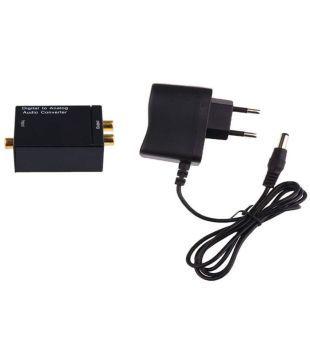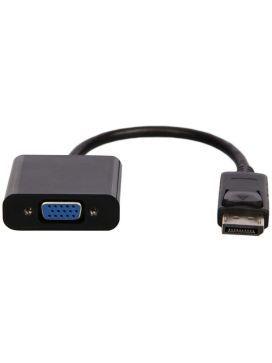Analog digital audio converter
Top sales list analog digital audio converter

India (All cities)
Digital to Analog Audio Converter is designed for either home or professional audio switching. It converts Coaxial or Toslink digital audio signals to analog L/R RCA audio and available for connection to an external device such as an amplifier via standard RCA-style jacks. Power Adapter. Digital to Analog Audio Converter Adapter. Full metal lightweight body, ensures heat dissipation performance inside. Supports sampling rate at 32kHZ, 44.1kHZ, 48kHZ, 96KHz and 192kHz, up to 24-bit resolution It converts Coaxial or Toslink digital audio signals to analouge L/R audio and available Provides electromagnetic noise free transmission Converts analog L/R signals to digital S/PDIF or TOSLink. Both TOSlink and Coax digital outputs may be used simultaneously
₹ 699
See product

Basavakalyan (Karnataka)
Product Details: Place of Origin: China Brand Name: eKL/OEM Model Number: eKL-VH Certification: ISO9001:2008 Payment & Shipping Terms: Price: negotiated Packaging Details: Gift Box Delivery Time: 3-10 days Payment Terms: TT Supply Ability: 1000Set/week Minimum Order Quantity: 5 Minimum Order Quantity: 10 SET VGA to HDMI converter,support VGA Intput resolution up to 1920*1080@60Hz; Support HDMI output resolution up to 1080@60Hz( the same as the Input resolution) 1. VGA to HDMI converter,1 port for VGA+L/R signal input, 1 port for HDMI signal output. 2. support VGA Intput resolution up to 1920*1080@60Hz 3. support VGA input resolution:VGA, SVGA, XGA, SXGA,WXGA,UXGA 4. support HDMI output resolution up to 1080@60Hz( the same as the Input resolution) 5. Support analog audio input(RCA port) 6. The ADC video processing technology, the signal is clear, efficient conversion 7. High-grade metal shell design, perfect hand feeling 8. Strict control of the raw materials, manufacturing and testing procedure under the ISO9001 standard, high quality and and Worry-free after-sales. contact : joyce at eklhd.com skype:joyce89f
₹ 11.000
See product

India
IVR stands for Interactive Voice Response, a technology that automates routine customer service interactions by allowing callers to interact using touch tone digits or their voice. A basic example of an IVR application is an automated attendant or voice menu: callers are presented with a recorded menu and respond by selecting a digit or, in some cases, by entering an extension number. The automated attendant eliminates the need for a live operator to handle the call. More complex applications include perscription refill for pharmacies, password reset, voice surveys, account balance inquiries, flight status checks, package tracking, pre-sales qualification questionnaires, etc. The key idea is to automate a routine, repetitive task that would otherwise require the time and effort of an employee. The savings potential gives IVR solutions a very rapid return on investment (ROI), as on server can potentially eliminate multiple live agents. IVR systems are historically sold at a premium, to large degree because of the strong ROI. A system with four ports (and thus capable of processing four concurrent calls) could cost thousands of dollars. Like conference bridging, voice messaging and other communications applications, IVR is generally an add-on component for a traditional phone system. Key Facts & FeaturesAll IVR systems are capable of prompting (playing audio) and collecting digits from the caller. Replacing the touch-tone interface with a voice interface requires additional software and significantly increases the expense of the platform. IVR platforms usually provide a means for recording audio from the caller. This can be used to record prompts, but the quality is generally quite poor. Most systems will also accept pre-recorded audio, and there are professional voice talents that offer custom prompts. IVR applications frequently interact with other data systems. This is often done using direct access to relational database systems through technologies like ODBC or by using making web service calls using protocols like REST or SOAP. Many IVR systems are sold as a runtime platform, meaning that business applications will need to be purchased or custom built. Frequently the service creation environment is an additional charge. Traditional IVR systems interface with the PSTN or a PBX system using either analog or digital trunks. More recent IVR systems support connections over IP using SIP. Legacy platforms tend to license by the port, while IP systems license by the concurrent call. IVR systems can be connected directly to the PSTN or they can be integrated with a business phone system. Systems that are directly connected to the PSTN support "terminal" applications -- applications that never require redirecting the caller to a live agent. Integrated IVR systems, on the other hand, can route calls to other resources within a business or even outside of it. Key BenefitsThe primary benefit of IVR is the savings compared to hiring staff to handle boring and repetitive tasks. Automating basic customer service functions makes sense in situations where the task is relatively simple and the input and output values can be conveyed by phone. Another benefit is the unlimited hours that an IVR system can put in each day. With a properly configured IVR system your company can offer top notch customer service even when closed for the evening or weekend. IVR systems can easily support multiple languages, allowing your business to service international markets abroad and multi-lingual customers at home.
See product

India (All cities)
Espouse DP To VGA Converter:- Compatible with MACOS and PCs, Display resolution up to: 1920x1200(WUXGA-R) @60Hz 8bpc: 154MHz; 1920x1080P @60Hz 10bpc: 144MHz This simple Plug and Play adapter feature a pure hardware design with an integrated chip to provide an active digital to analog conversion so that no software or drivers are required. Simply connect the adapter to your DisplayPort video source and plug your VGA cable into your monitor. ITS NOT "HDMI TO VGA OR “USB TO VGA" ADAPTER ITS ONLY - DisplayPort (DP) Male to VGA Female Cable Adapter Connect a DisplayPort (DP, DP++, DisplayPort++) equipped laptop or desktop to a monitor or projector with VGA input; A VGA cable (sold separately) is required Product Features:- Plug and Play Strong and Durable build quality 24k Gold plated connecter High Quality fitting Compact Design Ensure long life span Support: 1920 X 1080P Full HD Warranty:- Warranty Summary:- 1 year Manufacturer Warranty Covered in Warranty:- Manufacturer Not Covered in Warranty:- Physical Damage/Water Damage / Damage Product Warranty Service Type:- Carry In
₹ 266
See product

India (All cities)
Shop wireless multi-room hi-res music streamer for your home. It is easily connect the NODE 2i wireless music streamer to any existing stereo system to unlock and discover a universe of audio streaming. The Hi-Res music streamer amplifier is available with more than enough analog and digital input/output options online streaming services. Visit our authorised music system store in Gurugram, India!
See product
